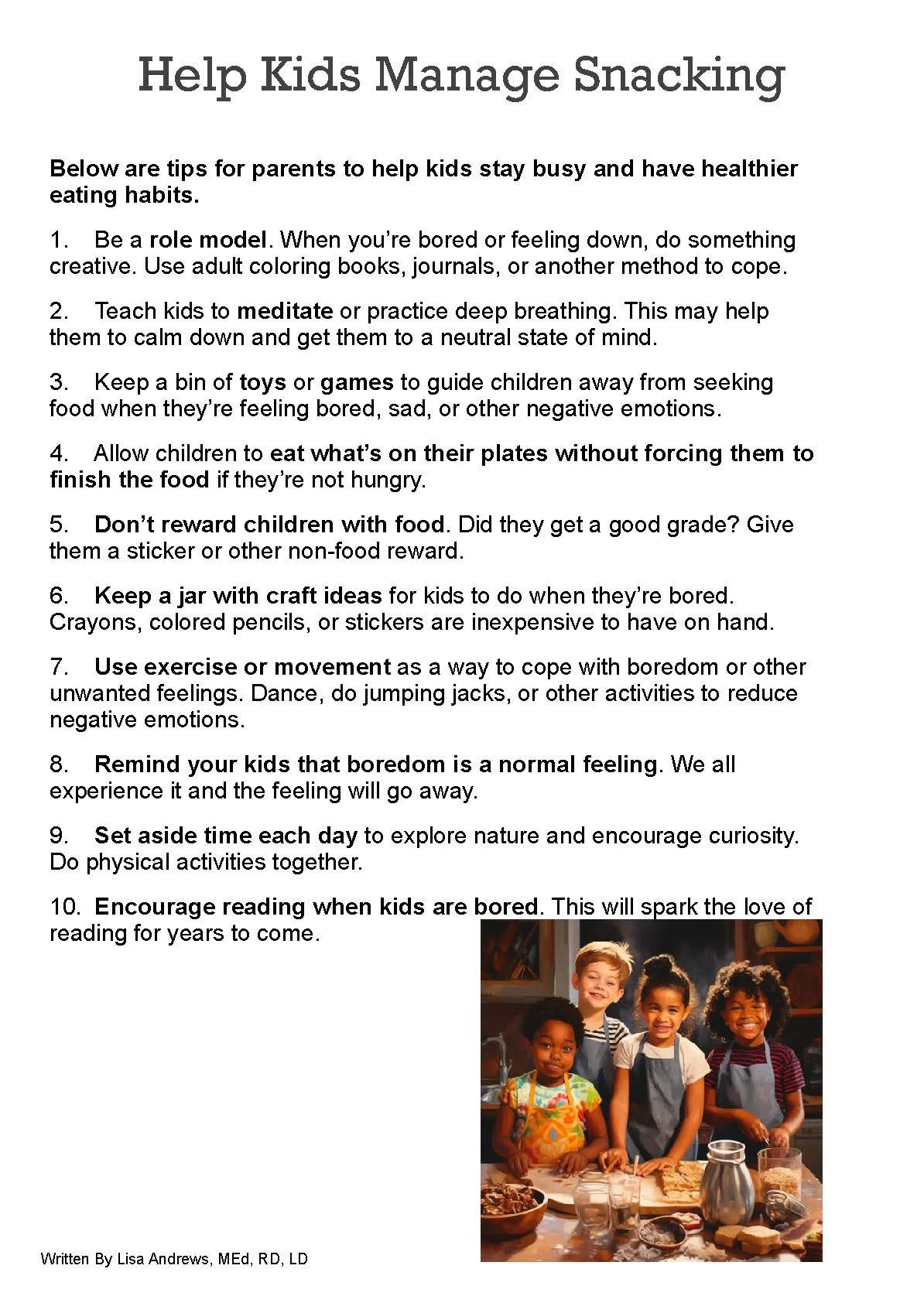Two Essential Handouts: Kids and Snacking
Research shows that bored kids eat more, so here is an article to keep them engaged along with 2 handouts to get kids on the right track this summer. Learn how boredom is a problem for kids who tend to overeat when bored—PLUS, give them healthier snack habits. Our article below has many good ideas to keep their minds engaged without their screens.
Keeping kids from getting bored requires a mix of engaging activities, stimulating environments, and a bit of creativity. Here are several strategies to help keep kids entertained and prevent boredom:
1. Plan a Variety of Activities
Arts and Crafts: Set up a creative space with supplies like paper, crayons, markers, glue, and scissors for drawing, painting, and crafting.
Outdoor Play: Encourage outdoor activities such as playing in the park, riding bikes, hiking, or organizing scavenger hunts.
Educational Games: Use puzzles, board games, or educational apps and games to keep their minds active.
Cooking and Baking: Involve kids in the kitchen with simple recipes they can help prepare.
2. Establish a Routine
Daily Schedule: Create a daily schedule that includes a mix of structured activities and free play. Having a routine helps kids know what to expect and keeps them engaged.
Quiet Time: Include periods of quiet time for reading, drawing, or playing with puzzles to balance more active parts of the day.
3. Incorporate Physical Activity
Sports and Exercise: Enroll kids in sports teams, dance classes, or other physical activities that they enjoy.
Indoor Exercise: On rainy days, try indoor activities like yoga for kids, dance parties, or obstacle courses using household items.
4. Encourage Independent Play
Toy Rotation: Rotate toys to keep things fresh and interesting. Store some toys away and bring them out later to rekindle interest.
Creative Play: Provide materials for building and imaginative play, such as building blocks, dress-up clothes, and playsets.
5. Foster Learning and Curiosity
Science Experiments: Conduct simple science experiments at home to spark curiosity and learning.
Library Visits: Regularly visit the library to check out books and participate in storytime sessions or other programs.
6. Social Interaction
Playdates: Arrange playdates with friends or family members to provide social interaction.
Community Events: Participate in community events, such as local fairs, festivals, or museum visits.
7. Technology and Screen Time
Educational Programs: Allow screen time with educational TV shows, documentaries, or learning apps.
Interactive Content: Use interactive apps and games that promote learning and creativity.
8. Involve Them in Household Tasks
Chores: Assign age-appropriate chores to teach responsibility and keep them occupied.
Gardening: Involve them in gardening activities like planting seeds, watering plants, and harvesting vegetables.
9. Creative Challenges and Projects
Challenges: Set up challenges such as building the tallest tower with blocks or creating the most imaginative drawing.
Long-term Projects: Start a long-term project like a family scrapbook, a garden, or a craft project that they can work on over time.
10. Encourage Hobbies and Interests
Discover New Interests: Introduce kids to new hobbies such as music, dance, photography, or collecting.
Support Existing Interests: Encourage them to dive deeper into their existing interests by providing resources and opportunities for exploration.
By mixing structured activities with free play and balancing indoor and outdoor time, you can keep kids engaged, entertained, and learning, reducing the chances of boredom.



